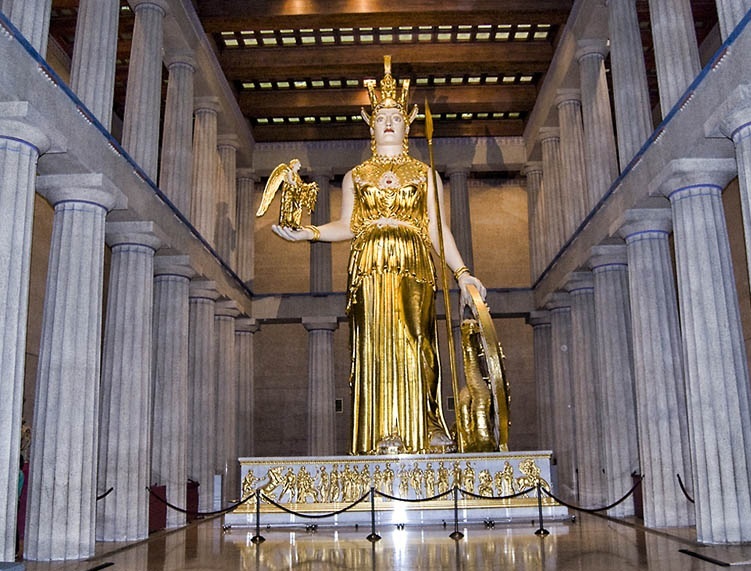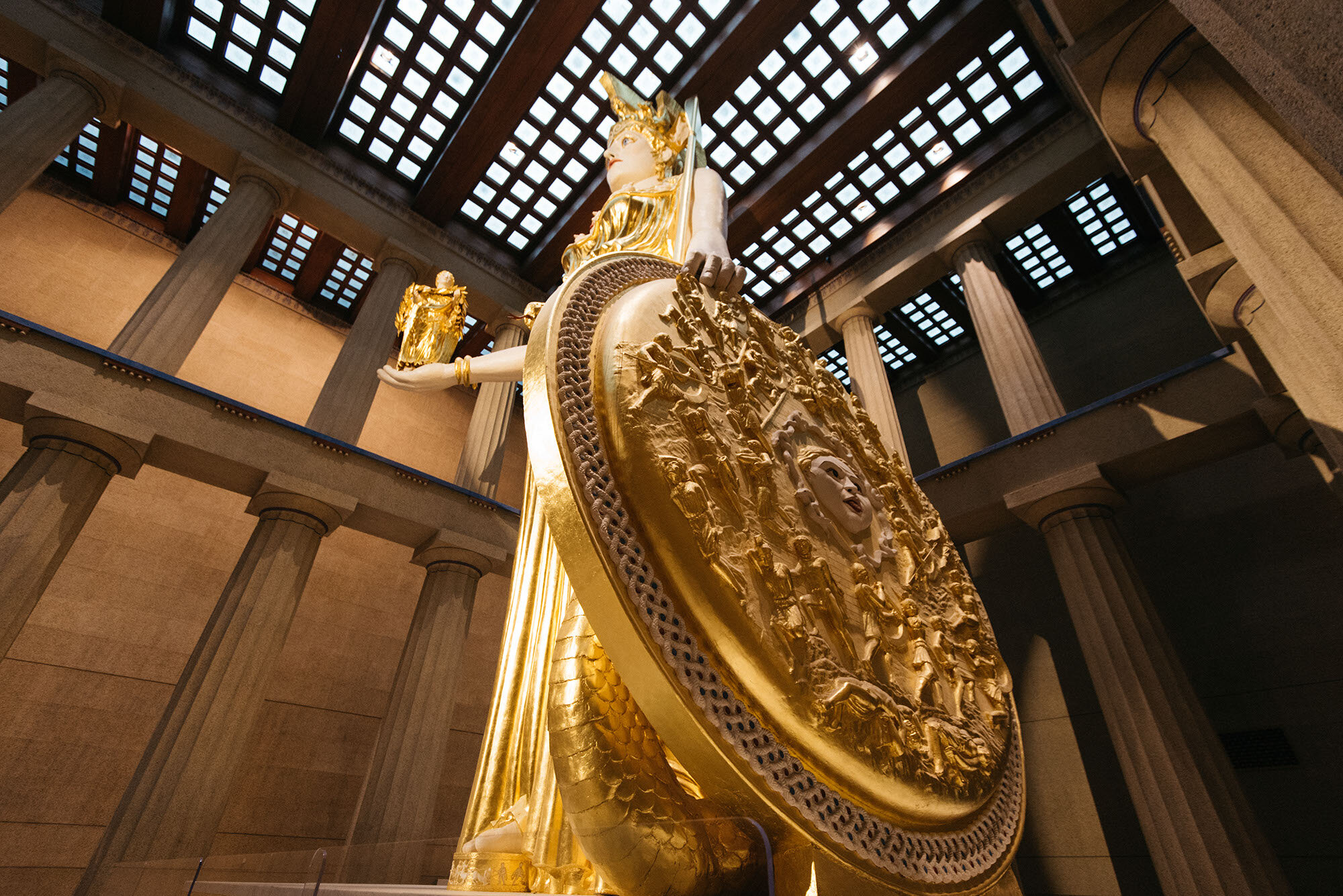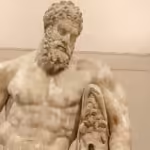Athena Parthenos, an extraordinary manifestation of divine wisdom and warfare, stands as a lasting symbol of ancient Athens. This monumental statue not only represents the artistic mastery of its time but also embodies the cultural and religious essence that defined the city-state. Crafted by the renowned sculptor Phidias in the fifth century BCE, Athena Parthenos is an emblem of intellectual prowess and military strength, capturing the hearts and minds of Athenian citizens while influencing the world beyond.
The grandeur of this statue encapsulates a significant period in history—an era marked by philosophical inquiry, military conquests, and artistic achievements. As we delve deeper into the multifaceted dimensions of Athena Parthenos, we will explore her creation, role in society, artistic significance, and enduring impact on culture and mythology.
The Artistic Mastery Behind Athena Parthenos
To appreciate the profound significance of Athena Parthenos, one must first understand the artistry involved in her creation. The statue was not merely a representation of the goddess but a testament to the technical skill and creativity of the sculptor Phidias, whose legacy continues to resonate in the art world.
Phidias and His Vision
Phidias, a master sculptor of classical antiquity, was commissioned to create the statue as part of the larger architectural project of the Parthenon. His vision extended beyond mere representation; it aimed to convey the virtues and ideals of Athenian society through Athena’s image.
Phidias’s craftsmanship was unparalleled, utilizing the chryselephantine technique, which combined gold and ivory to create life-like features. This method not only showcased his dexterity but also emphasized the divine nature of Athena. The intricate details—from the delicate folds of her garments to the fierce expression on her face—captured the essence of a powerful yet graceful deity.
Moreover, Phidias sought to embody the ideals of beauty and harmony that were central to Athenian identity. He understood that the statue would serve as both a religious icon and a public symbol, reflecting the values of freedom, intellect, and military prowess cherished by the Athenians.
Symbolism in Design
Every aspect of Athena Parthenos was imbued with symbolic meaning, establishing a connection between the goddess and the people of Athens. The towering figure, standing approximately 12 meters high, commanded attention and reverence. Her imposing stature signified authority and protection over the city.
In her right hand, she held a Nike, the goddess of victory, representing triumph in war and peace alike. This detail suggested that the Athenian people should aspire to attain greatness and success, further reinforcing the city’s aspirations during its Golden Age.
Additionally, the elaborate drapery of her garments symbolized the fluidity and strength of the Athenian spirit. The flowing lines of Athena’s attire evoked a sense of motion and vitality, reflecting the dynamic energy of a civilization at its peak. In contrast, the stern expression on her face highlighted her role as a protector, ensuring the safety and prosperity of her city.
A Monumental Presence

The location of Athena Parthenos within the Parthenon itself added to her monumental presence. The temple, designed as a sanctuary for the goddess, became an integral part of the Athenian identity. Citizens would gather for festivals and ceremonies, surrounding the statue with reverence and admiration.
The sheer scale of the statue ensured that it dominated the space within the Parthenon, acting as a focal point for worship. It was not just a piece of art; it was a central figure in the social and spiritual life of the city. The gatherings around Athena Parthenos during religious festivals revealed the deep bond between the goddess and her followers, fostering a sense of community and shared identity among the people.
The Cultural Significance of Athena Parthenos

The prominence of Athena Parthenos transcended mere artistic achievement; it was a reflection of the values and beliefs that defined Athenian society. The statue served as a powerful cultural icon, representing ideals that were deeply ingrained in the collective consciousness of the people.
A Symbol of Democracy and Freedom

In the democratic city-state of Athens, Athena Parthenos emerged as a beacon of hope and inspiration. As a goddess associated with wisdom and strategy, Athena personified the values that underpinned the democratic process. She encouraged rational thought, civic engagement, and the pursuit of knowledge.
The Athenians viewed her as a divine protector of their political system, which prioritized the voices and rights of citizens. The inclusion of Athena in their public life reinforced the notion that intelligence and thoughtful governance were paramount. Through the imagery of Athena Parthenos, the citizens found affirmation of their commitment to democracy—a system founded on the principles of equality and participation.
The Role in Religious Practices

Athena Parthenos wasn’t just a symbol of political values; she held immense religious significance. The statue played a pivotal role in various rituals and ceremonies dedicated to the goddess. Festivals such as the Panathenaea celebrated her contributions to the city, drawing thousands of participants who honored her through music, athletics, and sacrifices.
These events intertwined civic pride with spiritual devotion, allowing the citizens to express their gratitude and reverence. By addressing Athena as a nurturing and protective figure, they cultivated a connection that fostered a deep sense of belonging within the community. The statue stood as a reminder that the welfare of Athens relied upon the favor of their divine patroness.
Artistic Influence Across Generations
The impact of Athena Parthenos extended far beyond her immediate context. The artistic techniques employed by Phidias influenced countless generations of sculptors and artists. The ideals embodied in the statue—balance, proportion, and beauty—became foundational elements within Western art.
Throughout history, the image of Athena has been adapted and reinterpreted in various forms, from Renaissance masterpieces to contemporary works. Artists have drawn inspiration from her powerful presence, often associating their creations with themes of wisdom, strength, and femininity. This enduring influence serves as a testament to the statue’s significance as a cultural touchstone that continues to resonate across different eras.
Mythological Narratives Surrounding Athena Parthenos

Beyond her artistic and cultural significance, Athena Parthenos occupies a prominent position within Greek mythology. The narratives surrounding her character provide insights into the archetypal qualities she represents—wisdom, courage, and strategic prowess.
The Birth of Athena

Athena’s origins are steeped in myth, revealing her unique status among the pantheon of gods. According to legend, she was born fully grown and armored from the forehead of Zeus, the king of the gods. This miraculous birth symbolizes the union of intellect and strength, suggesting that true power comes from knowledge and wisdom rather than brute force.
This narrative reinforces the notion that Athena Parthenos embodies the best traits of Athenian society—intellect, strategic thinking, and moral virtue. The story of her birth underscores her role as a protector and guide for the city, further solidifying the importance of her statue within the civic landscape of Athens.
The Contest with Poseidon
One of the most famous myths involving Athena is her contest with Poseidon for the patronage of the city. Both deities offered gifts to the residents of Attica, with Poseidon striking the ground to produce a saltwater spring, while Athena provided the olive tree. The citizens chose Athena’s gift, recognizing its value in providing sustenance, oil, and wood.
This myth highlights the theme of wisdom prevailing over strength. Athena’s victory symbolizes the superiority of thoughtful choices over impulsive actions, aligning perfectly with the values cherished by the Athenian populace. As such, Athena Parthenos became synonymous with the triumph of reason and intellect, inspiring generations to embrace similar ideals.
Athena in War and Peace

Athena’s dual nature as a goddess of warfare and wisdom resonates throughout various myths. Unlike Ares, the god of war who represented chaos and destruction, Athena embodied strategic warfare and protection. She was frequently depicted assisting heroes like Odysseus and Perseus, guiding them towards their goals with her wisdom and advice.
Her involvement in these stories underscores the belief that true strength lies not just in physical might but in careful planning and intelligent decision-making. This duality reflects the complexities of human experience, showcasing Athena as a figure who inspires individuals to navigate challenges with both courage and insight.
The Lasting Impact of Athena Parthenos

Even after the original statue no longer exists, the influence of Athena Parthenos persists in modern culture. The goddess continues to be a source of inspiration in various fields, including literature, art, and philosophy.
Inspiration in the Arts
Throughout history, artists have sought to capture the essence of Athena in their works. From the classical sculptures of the Renaissance to the modern reinterpretations in contemporary art, her image serves as a canvas upon which diverse interpretations can flourish.
For instance, the embodiment of Athena in literary works often reflects themes of female empowerment and intellectual strength. Many authors draw parallels between their protagonists and the qualities attributed to the goddess, emphasizing the virtues of wisdom, bravery, and resilience. In this way, Athena’s legacy continues to influence the portrayal of women in literature and art, inviting new generations to explore the depths of her character.
Modern Philosophical Reflections
The ideals espoused by Athena Parthenos find resonance in modern philosophical discussions around ethics, democracy, and leadership. Thinkers and scholars reference her as a symbol of wisdom in navigating complex societal issues. The concept of integrating intelligence with moral responsibility echoes Athena’s approach to governance and warfare, serving as a guiding principle for contemporary leaders.
Furthermore, the juxtaposition of her martial and intellectual attributes prompts discussions about the nature of power. What does it mean to wield power responsibly? How can one balance strength with compassion? These questions reflect the ongoing relevance of Athena’s character in our quest for ethical leadership and societal progress.
Embodiment of Feminine Strength
Athena Parthenos serves as a powerful emblem of feminine strength and independence. In today’s context, she is invoked in conversations about gender equality, challenging traditional norms and roles assigned to women. Her portrayal as a warrior goddess who possesses both intellect and physical prowess encourages women to embrace their multifaceted identities.
Through the lens of Athena, contemporary movements advocating for women’s rights and empowerment draw inspiration from her unwavering strength and wisdom. She reminds us that the journey toward achieving equity and respect is rooted in the recognition of one’s capabilities and the cultivation of knowledge.
Conclusion

The legacy of Athena Parthenos is a testament to the enduring power of art, culture, and mythology. As a symbol of wisdom, strength, and civic virtue, she continues to inspire generations, bridging the gap between ancient ideals and modern realities. The statue crafted by Phidias was not merely a work of art; it became a reflection of the values that shaped Athenian society and a source of guidance for those seeking to navigate the complexities of life.
As we reflect on the significance of Athena Parthenos, we recognize that her image transcends time, reminding us of the importance of wisdom, courage, and community. In an ever-changing world, her lessons remain relevant, encouraging us all to seek knowledge, embrace strength, and strive for a harmonious existence.
✉️ Stay Connected — Subscribe for Weekly Updates
Discover timeless stories, practical wisdom, and beautiful culture — delivered straight to your inbox.
*We only share valuable insights — no spam, ever.






